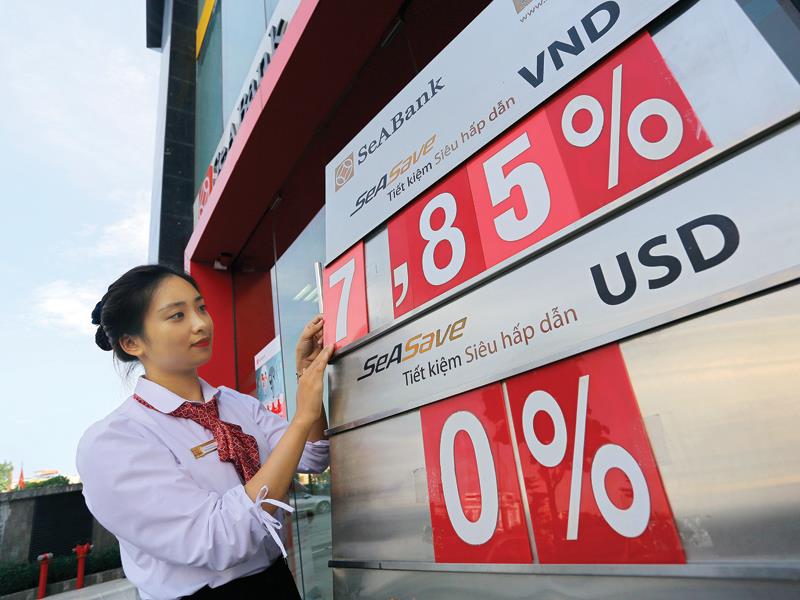Experts call to raise USD deposit rate
 |
| The difference between the VND and USD-based deposit interest rates is more than six percentage points per year (Photo: Dung Minh) |
| RELATED CONTENTS: | |
| Exchange rates stable despite Fed rate hikes | |
| Interest rates rising, banks stablising | |
| VN banks struggle to keep interest rates steady | |
Double exchange rate pressure
On June 14, 2017, the Federal Reserve (Fed) raised the interest rate by 0.25 per cent. It was the third hike since December. Surprisingly, after Fed’s announcement, the domestic foreign exchange market remained stable. According to economist Dr Can Van Luc, there are many reasons behind this stability.
“Besides the fact that financial markets in the world did not fluctuate significantly, there are other reasons. The “central exchange rate” control mechanism protected the Vietnamese economy to a remarkable degree from the influences of the world financial market. However, the most important thing is that the supply and demand of foreign currency in Vietnam is stable. The supply of foreign currency from exports, foreign direct investment, official development assistance (ODA) fund disbursement, tourism, and overseas remittances increased steadily in the first five months of 2017,” Luc said.
Although the exchange rate was not altered after the Fed’s decision, many experts called attention to exchange rate pressures. This originates from the rising trade deficit and foreign currency loans.
“Since the beginning of 2017, trade deficit reached $2.5 billion. It may rise to $7 billion by the end of this year, which would put pressure on the VND/USD exchange rate in some periods,” Ngo Dang Khoa, country head of global markets at HSBC Bank Vietnam, said, adding that enterprises which operate in industries largely affected by interest rate fluctuations and exchange rate risks should closely monitor the market and prepare for appropriate risk management.
Making the same statement as Khoa, Dr Luc added that foreign currency loans increased by 4.64 per cent in the first four months of 2017, while the same period last year experienced no such increases. Along with the trade deficit, increasing foreign currency loans put pressure on the VND/USD exchange rate.
Raise or not to raise?
| Four reasons for SBV to raise the USD deposit rate First, USD is appreciating in global financial markets and is likely to continue to do so in the future. Second, in Vietnam, the demand for foreign currency usage and loans is high, making it necessary to raise USD. Third, even if SBV raised the USD deposit rate to 0.5 percentage points, it would still be cheaper than borrowing USD loans from a foreign country, as the interest rate on USD loans in other countries is at least 1.5-2 per cent per year. Finally, raising the USD deposit rate will make commercial banks more transparent. Currently, although the USD deposit rate is zero, most commercial banks have promotion programmes for their clients, so the actual USD deposit rate is higher than zero. |
The zero interest rate policy on USD deposits is applied by SBV since 2015. Along with many other policies, this measure has decreased dollarisation in the Vietnamese economy. However, this policy is showing some shortcomings when overseas remittances are on a downward trend and commercial banks are finding loopholes in regulations to increase their USD deposits.
A representative said that the SBV is reviewing these shortcomings and is considering policy adjustments. According to speculations, there are two main additional reasons why SBV is still considering the move, the first being the worry about dollarisation and the second the fact that USD holdings among the population are small and not worth throwing out a good policy over.
Dr Luc, who has time and again proposed SBV to raise the USD deposit rate, said that it is hard to tell the exact amount of USD holdings among the population and it should be carefully assessed. However, when the Vietnamese economy has a shortage of foreign currency, the more USD deposits, the better.
Regarding the worry about dollarisation, according to Dr Luc, the problem is not worth worrying about. Even when the USD deposit rate was raised to 0.25 per cent as it used to be in the past, people will not straight-out switch from USD to VND deposits, because the difference remains significant, at more than six percentage points per year.
Previously, when talking to VIR, economist Dr Le Xuan Nghia said that the simplest way to raise USD deposits is to raise the deposit rate and give permission to USD loans. When there is an abundant supply of USD, commercial banks have to reduce USD interest rates, after which the loan rates will even out.
What the stars mean:
★ Poor ★ ★ Promising ★★★ Good ★★★★ Very good ★★★★★ Exceptional
Latest News
More News
- Banks gear up for massive capital increases (December 18, 2025 | 17:04)
- Securing capital and efficiency for Vietnam’s 2026-2030 growth ambitions (December 17, 2025 | 10:00)
- Energy sector in need of blended finance mechanisms (December 17, 2025 | 09:00)
- Vietnam still has room to mobilise capital for sustainable growth (December 17, 2025 | 08:57)
- Long-term capital seen as key hurdle to green growth (December 16, 2025 | 08:00)
- Gold prices swing amid tax debate and import uncertainty (December 15, 2025 | 18:04)
- Agribank frames bank credit as catalyst for green growth (December 15, 2025 | 17:59)
- Vietnam’s green transition demands collective financial action (December 15, 2025 | 12:00)
- VIR workshop highlights capital and policy for sustainable development (December 15, 2025 | 11:00)
- Promoting digital assets initiative in Vietnam (December 13, 2025 | 09:30)


















 Mobile Version
Mobile Version